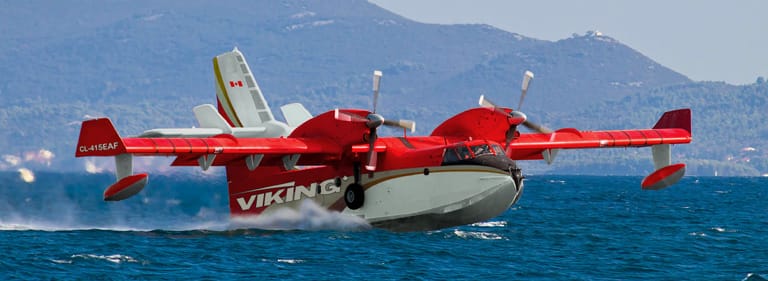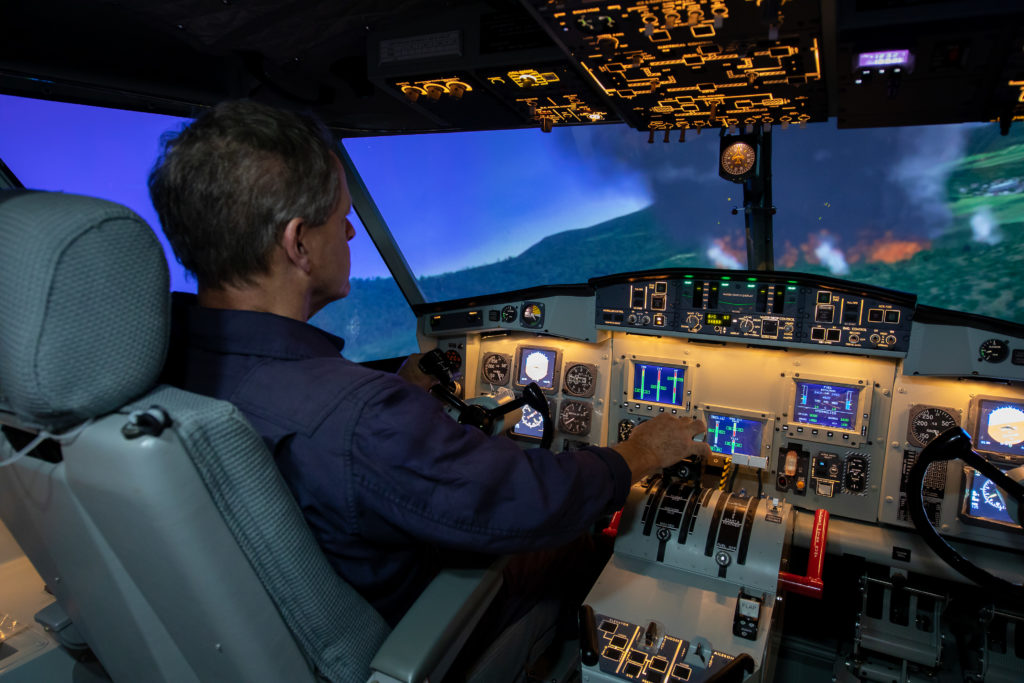Estimated reading time 6 minutes, 41 seconds.
The Viking CL-415 “SuperScooper” is more akin to a pick-up truck than a sports car.
It’s a hardworking, amphibious turboprop that was built to fight wildfires.

It flies low, battling blistering heat and blinding smoke, before releasing 13,500 pounds of water in six seconds – and then returning to a nearby lake where it skims the surface to reload.
Introduced in 1993 by Bombardier, the CL-415 was essentially a turboprop version of its predecessor, the piston-powered CL-215. Today, there are close to 170 CL-215/415 aircraft in operation, mostly in Europe and North America. They are now supported by Viking Air, which acquired the program from Bombardier in 2016.
Pilot training in the CL-415 has historically been done in the aircraft, but TRU Simulation + Training says that due to the unique mission it performs, those training flights can be dangerous.
The South Carolina-headquartered company is a division of industry giant Textron Inc., and was formed following the amalgamation of several specialty flight simulation and pilot training companies, including former Montreal-based Mechtronix.

About two years ago, TRU’s commercial aviation division in Montreal began designing the world’s first CL-415 full flight simulator (FFS) with the capability to replicate operations not only in the air, but also on the water. The company was able to draw on its recent experience of successfully building a Series 400 Twin Otter FFS for Canada’s Pacific Sky Aviation in Calgary, Alta. – the world’s first seaplane simulator with water-handling capabilities.
“Before the Twin Otter project, hydrodynamic modelling is something we hadn’t done before,” acknowledged Thom Allen, TRU’s vice-president of Technology and Innovation. “It’s like a boat simulator because you’re modelling the buoyancy of the floats or the fuselage in the water. Interestingly, our engineers working on the Twin Otter program actually went to the library and researched how boats work on the water. Mixing the boat sim with the aerodynamic sim is the whole package.”
He said the CL-415 experience took things one step further by adding the mission component – scooping the water – to the Twin Otter build.
“From a safety point of view, the types of missions you do in a waterbomber are quite a bit different from a commercial aircraft. When you’re scooping water and dropping it over a fire, training in those conditions is very dangerous. The tradeoff has always been between the quality of the training and the danger of doing that sort of training.”
TRU’s CL-415 FFS was delivered to Ansett Aviation Training in Milan, Italy, in September 2018 and certified by the European Aviation Safety Agency (EASA) in December to Level D standards. Although training courses have yet to be completed in the simulator, the hope is that both initial and recurrent pilot training will be done exclusively in the device.
Allen said the operational characteristics of a CL-415 are complex and unique.
“When you’re flying over a very hot fire, you drop your water and the mass of the aircraft is cut in half. The turbulence effect is quite significant when you hit the updraft. The fire is creating turbulence, smoke, reduced visibility – and pilots are dropping every five or 10 minutes repeatedly, usually in rugged terrain at low altitudes. This is the part that made this project something new.”
To gather accurate performance data, TRU rented a CL-415 and equipped it with flight test instrumentation.
“We weren’t doing fire drops with our engineers on board, but we did all the manoeuvres around that, and we brought in a number of senior CL-415 pilots to evaluate our work.”
The result is the world’s first high fidelity CL-415 simulator with the capability of replicating not just air and water operations, but various types and intensities of forest fires and changes in related environmental conditions. The cockpit noise level is accurately reproduced by a secondary audio system that – like the real aircraft – requires crewmembers to wear a noise-cancelling headset.
TRU said the simulator comes at a time when the number of wildfires is increasing worldwide, and the demand for waterbomber pilots is high.

Ansett Aviation, named as a member of Viking Air’s amphibious aircraft division support network in 2017, is now working with customers to begin its formal training program.
“Because it’s the only sim in existence for that aircraft, now that it’s available, people will be coming from all over to train,” predicted Allen. At some point, he expects there will be a business case for another CL-415 simulator in North America.
TRU has customer support personnel onsite in Milan and simulator upgrades will keep pace with the evolution of the worldwide fleet.
Allen said the project was both challenging and exciting for TRU.
“During the qualification with EASA, one of the senior authorities said this was one of the most exciting qualifications he’d ever done,” he concluded. “The reaction with the water, the fire, the mission aspect of it, has been very positive. It’s quite unique and exciting.”








